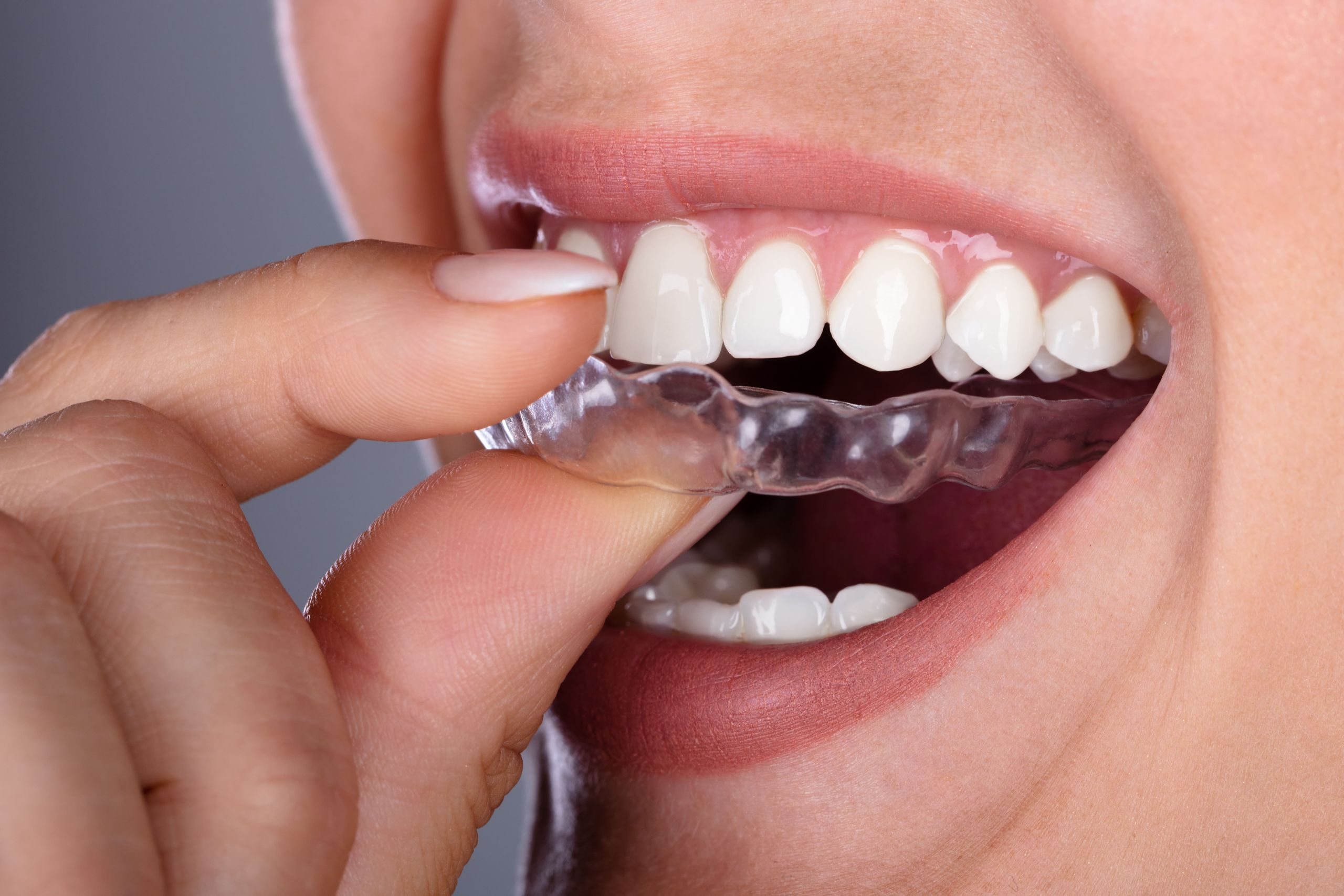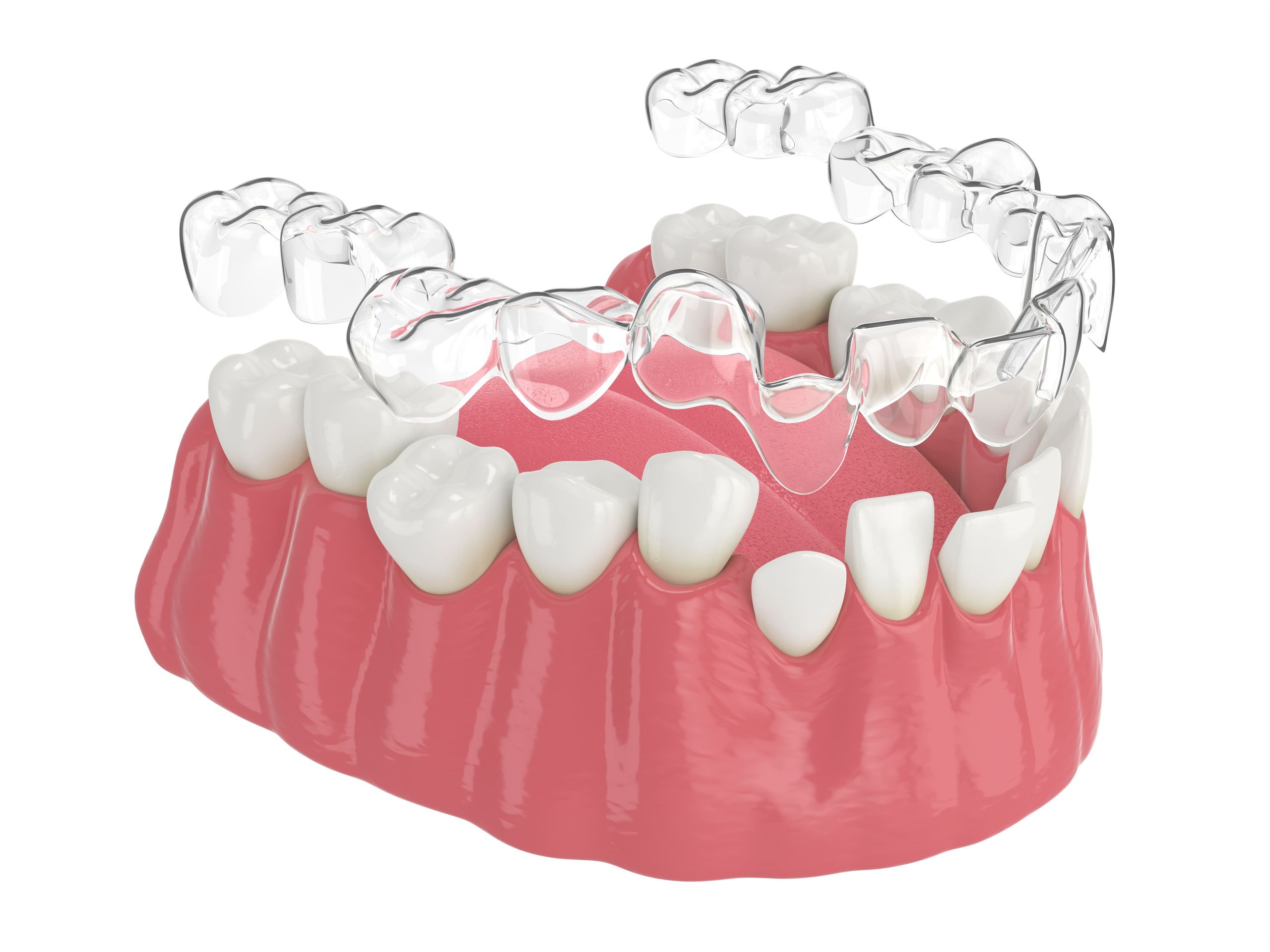- Home
- Blog
- Digital dentistry
- Clear Aligners
Clear aligners — comfortable orthodontic treatments with digital dental solutions
How do clear aligners work?
Clear aligners straighten teeth and can be used as an alternative to metal braces. Over the past decade, their use has grown tremendously in popularity. This is for many reasons.
Patients tend to prefer clear aligner teeth straightening mainly because they are transparent and considered invisible for the wearer. Because of this, teenagers and especially in the last few years, adults, have embraced clear aligner therapy as a cure for their tooth alignment issues. In addition, studies have documented invisible teeth aligners can reduce treatment duration — an important consideration for any patient 2. Ke Y, Zhu Y, Zhu M. A comparison of treatment effectiveness between clear aligner and fixed appliance therapies. BMC Oral Health. 2019 Jan 23;19(1):24. doi: 10.1186/s12903-018-0695-z. PMID: 30674307; PMCID: PMC6343314. .
Dental aligners are made with clear, medical-grade, BPA-free plastic, like a mouth guard, that covers the teeth. Instead of being attached to your teeth, they are removable, similarly to, for example, a sports mouth guard. When you have an aligner treatment you are given a set of clear plastic teeth aligners. Each aligner is designed to move your teeth a little bit more in a desired direction. The aligners are changed every 7-14 days as the treatment progresses.
The number of aligners needed for your treatment can vary. With the range dependent on the requirements of the treatment. Additionally, patient compliance, in other words, are you wearing your aligners as prescribed, is essential for a successful treatment.
The orthodontic aligners move the teeth by putting mild pressure on them, which is then transferred to the roots and the jaw. The jaw responds by moving your teeth sockets, and the teeth.
Because the aligners work incrementally, the treatment tends to be gentler. Unlike metal braces, clear aligners are not attached to the teeth. However, because of this, attachments to your teeth, aptly named “attachments,” that work with the clear aligner and are sometimes needed to support the aligner treatment. The attachments are bonded to your teeth and are clear in color so as to be unnoticeable. The attachments help to apply pressure from the aligners onto the teeth and direct them into the proper alignment.
In some cases, elastics may also be needed. These function and are used similarly to the way elastics are applied with traditional metal braces and orthodontics.

What can clear aligners be used for?
Clear teeth aligners can be used for both minor and complex cases. Studies document the success of clear aligners versus braces on numerous types of treatment but caution that while teeth aligners can be used in mild to moderate crowding cases, caution should be exercised in complex cases 3. Tamer İ, Öztaş E, Marşan G. Orthodontic Treatment with Clear Aligners and The Scientific Reality Behind Their Marketing: A Literature Review. Turk J Orthod. 2019 Dec 1;32(4):241-246. doi: 10.5152/TurkJOrthod.2019.18083. PMID: 32110470; PMCID: PMC7018497..
Clear orthodontic aligners are used for treating:
- Crowded teeth —the overlapping of teeth.
- Diastema — small or large gaps between the teeth.
- Underbites —lower front teeth overlapping the upper front teeth.
- Overbites —upper front teeth overlapping the lower front teeth.
- Open bites — when upper and lower teeth slant outward and do not touch when biting down.
- Malocclusion with primary teeth — this is for children ages 6 and 10 years.
What are the clear teeth aligner options available?
One of the most attractive features of invisible teeth aligners is their availability options. Depending on your dentist or orthodontist, they can order your treatment directly from a company like ClearCorrect, SureSmile or 3M Clarity Aligners, or they can manufacture the invisible aligners themselves using software like 3Shape Clear Aligner Studio. Alternatively, patients can even purchase at-home aligners directly from companies like the SmileDirect Club.
In-Office Aligners vs. At-Home Aligners
What’s the difference? In-office aligners (like ClearCorrect and SureSmile) are well-known options and experienced clear aligner providers. To take advantage of an in-office aligner, patients need to visit a doctor associated with one of these providers. Nowadays, pretty much every dentist and orthodontic practice has an aligner provider option that the patient can choose from. You just need to consult with your dental professional.
As digital dentistry has grown in adoption, more advanced practitioners are choosing to produce the aligners in their own practice or with lab partners. In this way, they can pass the cost savings of producing the aligners themselves on to their patients.
To produce dental aligners, the practice not only needs digital imaging equipment like an intraoral scanner for orthodontic scanning, but manufacturing equipment like a 3D printer and vacuum forming machine. These require significant investment, so making in house clear aligners is not suitable for every dental practice.
At-home aligners, referred to also as direct-to-consumer aligners, are usually cheaper than in-office aligners. The entire treatment is conducted remotely. In other words, a patient may never visit a dentist or an orthodontist.
Direct-to-consumer aligners — such as SmileDirect Club, are recommended for treating only minor to moderate cases. If you require more extensive work, an at-home aligner provider will hopefully instead, refer you to a professional for treatment.
Nighttime clear aligners
Another alternative to In-Office Aligners and At-Home Aligners is Nighttime aligners. These are aligners that as their name implies, are worn only at night during sleep. While these may be convenient for patients, there is controversy around them and their effectiveness. Some doctors argue that because they are worn for a reduced amount of hours per day, they can do more harm than good. Saying that the nighttime aligners can leave teeth in a limbo state of inflammation because the teeth are only being moved for 10 hours per day on and off.
Are clear aligners painful?
Unlike metal braces, clear dental aligners are removable. The patient can take them off to eat, brush their teeth and floss. They are recommended to be worn 22 hours per day, which takes into account eating and hygiene. Because straightening aligners are designed most of the time via a digital impression, the aligners are made to precisely fit your teeth. That means taking them on and off, requires little effort. And in the case of any discomfort, they can easily be reshaped or resized.

How long does teeth aligner treatment last?
A clear aligner treatment usually lasts approximately 12 months. It depends upon the individual case needs, and of course, patient compliance, i.e., wearing the aligners as prescribed. This is a much different scenario when compared with metal braces where a treatment can take from 6 months to years.
Another important difference is again, the ability to remove the transparent aligners at any time to maintain good and optimal oral hygiene throughout the treatment period.
Four recent studies found that tested clear aligner groups had a shorter treatment duration than braces groups.
The study found that clear aligners had an advantage in the segmented movement of teeth and shortened treatment duration but were not as effective as braces in producing adequate occlusal contacts, controlling teeth torque, and retention 2. Ke Y, Zhu Y, Zhu M. A comparison of treatment effectiveness between clear aligner and fixed appliance therapies. BMC Oral Health. 2019 Jan 23;19(1):24. doi: 10.1186/s12903-018-0695-z. PMID: 30674307; PMCID: PMC6343314. .
Before and after treatment simulation with clear aligners
Most clear teeth aligner treatments are begun with a digital impression. That means using an intraoral scanner to scan the patient’s mouth and then sending the files for diagnosis and aligner manufacturing. Because an intraoral scanner is used, a digital image or picture of the patient’s mouth is created. The image or data can then be used with dental simulation software to create a treatment simulation for the doctor and patient.
With, for example, 3Shape’s TRIOS Treatment Simulator, you can automatically generate a simulated result of the orthodontic treatment, side-by-side with their current dentition. This can be used to help facilitate patient engagement and according to doctors, increase treatment acceptance rates. You can also adjust individual teeth in the simulation to create the ideal smile for a patient.
In addition, 3Shape has teamed up with Ivoclar Vivadent, so that doctors can combine the patient’s simulation and IvoSmile® Orthodontics to augment reality for real-time 3D visualization during the consultation — directly on the patient’s face.
How to choose the right invisible aligners?
As is the case with any medical treatment, any decision regarding which clear aligner provider to choose should be made by consulting a dental professional. There are many clear aligner providers available. That’s why 3Shape openly integrates its intraoral scanner with as many of them as possible.
Using 3Shape’s Unite platform (included free with TRIOS), TRIOS users can seamlessly send digital impressions to aligner makers they have found on the 3Shape Unite store. With some providers like ClearCorrect and SureSmile the integrations have been fully optimized to deliver a very smooth workflow for the dental professional.
Digital workflows have made it easier to not only begin a clear aligner treatment but also have it produced.
For dental professionals, we’ve created a list of dental clear aligner providers that are integrated with the 3Shape TRIOS intraoral scanner and also found in the Unite store. You can see the 3Shape integrated clear aligner providers here.
Clear aligners vs. braces: what’s the difference?
There are obviously major differences when comparing near invisible orthodontic aligners versus braces. But in the end, their goal is the same: to treat malocclusion. As described earlier, clear aligners are made with clear plastic. Instead of being attached to teeth like metal braces, they are removable.
Invisible aligners are also prescribed in sets where you use a new aligner every 7-14 days. The aligners are worn some 22 hours a day so patients can eat and practice hygiene without wearing the aligner. This is completely the opposite of metal braces which are fixed to teeth 24/7 and are controlled via attached wires that control the teeth movement.
Both aligners and braces move the teeth by putting pressure on them, which is then transferred to the roots and the jaw. Metal braces are recommended for more difficult cases according to studies 3. Tamer İ, Öztaş E, Marşan G. Orthodontic Treatment with Clear Aligners and The Scientific Reality Behind Their Marketing: A Literature Review. Turk J Orthod. 2019 Dec 1;32(4):241-246. doi: 10.5152/TurkJOrthod.2019.18083. PMID: 32110470; PMCID: PMC7018497..

What are the benefits of invisible teeth aligners?
The benefits of clear aligners for both patients and doctors are many. The obvious being that they are transparent and near unnoticeable when compared with braces. Invisible teeth correction can also mean less chairtime for doctors who can easily outsource the planning and production of the aligners.
Benefits of invisible teeth aligners for patients
For patients, clear aligners are considered a less intrusive more esthetic treatment for malocclusion or cosmetic corrections. The aligners are nearly invisible. They are easy to take on and off and maintain oral hygiene.
With braces, patients have to watch the foods they eat, especially hard or chewy food. With clear aligners you can just take it off and eat your favorite foods, brush right after and put the teeth aligner back in.
In addition, studies have documented that treatment time can be reduced with invisible aligners 4. Borda AF, Garfinkle JS, Covell DA, Wang M, Doyle L, Sedgley CM. Outcome assessment of orthodontic clear aligner vs fixed appliance treatment in a teenage population with mild malocclusions. Angle Orthod. 2020 Jul 1;90(4):485-490. doi: 10.2319/122919-844.1. PMID: 33378505; PMCID: PMC8028462.. In addition, with teeth aligners, the number of appointments needed with the doctor can be reduced 2. Ke Y, Zhu Y, Zhu M. A comparison of treatment effectiveness between clear aligner and fixed appliance therapies. BMC Oral Health. 2019 Jan 23;19(1):24. doi: 10.1186/s12903-018-0695-z. PMID: 30674307; PMCID: PMC6343314. . As there is no bonding, as with braces, or adjustments needed throughout the treatment period. In some cases, all that is needed is an intraoral scan appointment and the outsourcing of the planning and production to a clear aligner provider. There can be times though, when the aligners need to be modified to improve their comfort to the wearer.
Benefits of clear aligners for doctors
For doctors, clear aligners enable the clinician to easily outsource the planning and production of the treatment. In this way, a GP can recommend a patient to ClearCorrect, for example, without sending the patient first to an orthodontist. However, consulting an orthodontist regarding any teeth movement is generally recommended.
Dental practices have also found that offering a particular brand of clear aligners, or even in house clear aligners, is a good marketing tool for their practice and helps to increase patient numbers. Clear aligner design software like 3Shape Clear Aligner Studio and outsourcing to clear aligner providers has made the treatment very attractive to dental professionals. With an in house solution, doctors can produce their own clear aligners.
In an interview with 3Shape, US based orthodontist, Dr. Christian Groth, he said he believes that there are two key benefits with making clear aligners in house: “One is the ability to treat simple movement cases… relapse cases, and patients that have already been through treatment in your office. These are relatively straightforward with aligners made in house. The other is movement after deband. Everyone has had patients where you have small spaces, or small rotations that you want to take care of, but you don’t want to do that with brackets and wires. Either because hygiene is an issue, they are overtime, or the patient simply wants to get their braces off. You can easily design and manufacture a small number of aligners to get these movements taken care of and they are not done in fixed appliances. These are services that we could not offer before.”
Clear aligners — a booming market
According to the industry magazine, Dentistry Today, in a research study, “Clear Aligners Market to 2028 – Global Analysis and Forecast,” the teeth aligner market size was valued at US$ 2,695.07 million in 2021 and is projected to reach US$ 8,708.67 million by 2028. Market growth is expected at a CAGR of 15.9% over the next seven years — 2021-2028 5. Clear Aligners Market Forecast to 2028 - COVID-19 Impact and Global Analysis By Type Polyurethane Plastic, Polyethylene Terephthalate Glycol (PETG), and Poly-vinyl Chloride (PVC), Distribution Channels (Direct Sales, Laboratories, and Others), and Age (Adults and Teenagers). 2021 May. . It is also reported that 60-75% of the world’s population suffers from malocclusion.
The market for teeth aligners is clearly growing. Digital workflows powered by intraoral scanners like 3Shape TRIOS will help doctors take advantage of this growing market and provide their patients with the very in-demand treatment. Software like 3Shape Clear Aligner Studio and the 3Shape Unite platform, will make it easier than ever for practitioners to treat their patients with clear aligners.
Resources
- Global Clear Aligner Market: Analysis By End Users (Teenagers, Adults), By Region, By Country (2018 Edition): Opportunities and Forecast (2013-2023), By Region (North America, Europe, Asia Pacific, ROW), By Country (U.S., Canada, Mexico, United Kingdom, Germany, China, Japan, South Korea). 2018 Aug 30.
- Ke Y, Zhu Y, Zhu M. A comparison of treatment effectiveness between clear aligner and fixed appliance therapies. BMC Oral Health. 2019 Jan 23;19(1):24. doi: 10.1186/s12903-018-0695-z. PMID: 30674307; PMCID: PMC6343314.
- Tamer İ, Öztaş E, Marşan G. Orthodontic Treatment with Clear Aligners and The Scientific Reality Behind Their Marketing: A Literature Review. Turk J Orthod. 2019 Dec 1;32(4):241-246. doi: 10.5152/TurkJOrthod.2019.18083. PMID: 32110470; PMCID: PMC7018497.
- Borda AF, Garfinkle JS, Covell DA, Wang M, Doyle L, Sedgley CM. Outcome assessment of orthodontic clear aligner vs fixed appliance treatment in a teenage population with mild malocclusions. Angle Orthod. 2020 Jul 1;90(4):485-490. doi: 10.2319/122919-844.1. PMID: 33378505; PMCID: PMC8028462.
- Clear Aligners Market Forecast to 2028 - COVID-19 Impact and Global Analysis By Type Polyurethane Plastic, Polyethylene Terephthalate Glycol (PETG), and Poly-vinyl Chloride (PVC), Distribution Channels (Direct Sales, Laboratories, and Others), and Age (Adults and Teenagers). 2021 May.